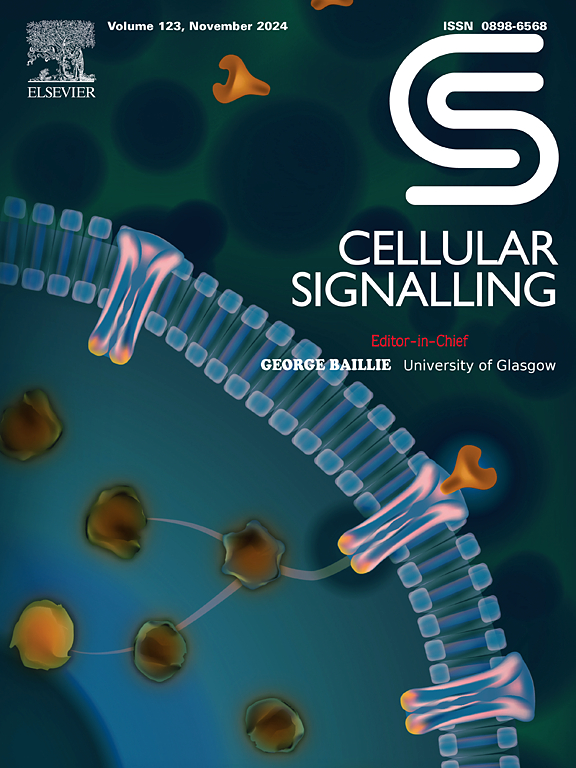Dapagliflozin activates the RAP1B/NRF2/GPX4 signaling and promotes mitochondrial biogenesis to alleviate vascular endothelial ferroptosis
IF 4.4
2区 生物学
Q2 CELL BIOLOGY
引用次数: 0
Abstract
Vascular endothelial ferroptosis is a key mechanism underlying endothelial injury and atherosclerotic plaque formation. Dapagliflozin, an essential medication in the management of heart failure, has been shown to delay atherosclerosis progression. However, the underlying mechanisms remain unclear. This study aimed to elucidate the molecular pathways whereby dapagliflozin inhibits vascular endothelial ferroptosis. We utilized human umbilical vein endothelial cells (HUVECs) to construct a cell model of atherosclerosis combined with ferroptosis. Dapagliflozin significantly decreased the iron and malondialdehyde levels and the release of inflammatory factors in HUVECs treated with oxidized low-density lipoprotein or Erastin but increased the superoxide dismutase activity and the reduced glutathione / oxidized glutathione ratio. Results from transmission electron microscopy indicated that dapagliflozin alleviated the mitochondrial shrinkage and the reduction in the number of cristae in these HUVECs. RNA sequencing revealed that dapagliflozin upregulates RAP1B. In vitro experiments showed that RAP1B upregulates NRF2 and promotes its nuclear translocation, activating the xCT/GPX4 signaling pathway and inhibiting lipid peroxidation. Additionally, dapagliflozin induces mitochondrial biogenesis and enhances oxidative phosphorylation through the RAP1B/NRF2 pathway, reducing iron overload and excessive production of mitochondrial reactive oxygen species, ultimately mitigating ferroptosis. At the animal level, we constructed an atherosclerosis model by using Apoe−/−; Rap1b−/− double-knockout mice. Rap1b knockout blocked the inhibitory effects of dapagliflozin on atherosclerotic plaque formation and ferroptosis activation. We confirmed in vivo that dapagliflozin upregulates GPX4 and key factors of mitochondrial biogenesis via RAP1B, promoting oxidative phosphorylation. When mitochondrial oxidative phosphorylation was pharmacologically inhibited, ferroptosis was reactivated, promoting atherosclerotic plaque formation. In conclusion, this study demonstrated that dapagliflozin activates the RAP1B/NRF2/GPX4 signaling pathway and promotes mitochondrial biogenesis, thereby alleviating vascular endothelial ferroptosis.

达格列清激活RAP1B/NRF2/GPX4信号通路,促进线粒体生物发生,缓解血管内皮铁下垂
血管内皮铁蛋白沉积是内皮损伤和动脉粥样硬化斑块形成的关键机制。达帕格列净是治疗心力衰竭的一种基本药物,已被证明可以延缓动脉粥样硬化的进展。然而,其潜在机制仍不清楚。本研究旨在阐明达帕格列净抑制血管内皮铁蛋白沉积的分子途径。我们利用人体脐静脉内皮细胞(HUVECs)构建了动脉粥样硬化合并铁蛋白沉积的细胞模型。达帕格列净能显著降低经氧化低密度脂蛋白或艾司他丁处理的 HUVECs 中的铁和丙二醛水平以及炎症因子的释放,但能提高超氧化物歧化酶活性和还原型谷胱甘肽/氧化型谷胱甘肽的比率。透射电子显微镜的结果表明,达帕格列净减轻了这些 HUVEC 中线粒体的萎缩和嵴数量的减少。RNA 测序显示,达帕格列净可上调 RAP1B。体外实验显示,RAP1B 上调 NRF2 并促进其核转位,激活 xCT/GPX4 信号通路并抑制脂质过氧化。此外,达帕格列净通过RAP1B/NRF2途径诱导线粒体生物生成并增强氧化磷酸化,减少铁超载和线粒体活性氧的过度产生,最终缓解铁中毒。在动物层面,我们利用 Apoe-/-; Rap1b-/- 双基因敲除小鼠构建了动脉粥样硬化模型。Rap1b 基因敲除阻断了达帕格列净对动脉粥样硬化斑块形成和铁氧化酶激活的抑制作用。我们在体内证实,达帕格列净通过 RAP1B 上调 GPX4 和线粒体生物生成的关键因子,促进氧化磷酸化。当线粒体氧化磷酸化受到药物抑制时,铁蛋白沉积被重新激活,从而促进动脉粥样硬化斑块的形成。总之,本研究证明达帕格列净可激活RAP1B/NRF2/GPX4信号通路,促进线粒体生物生成,从而缓解血管内皮铁沉着。
本文章由计算机程序翻译,如有差异,请以英文原文为准。
求助全文
约1分钟内获得全文
求助全文
来源期刊

Cellular signalling
生物-细胞生物学
CiteScore
8.40
自引率
0.00%
发文量
250
审稿时长
27 days
期刊介绍:
Cellular Signalling publishes original research describing fundamental and clinical findings on the mechanisms, actions and structural components of cellular signalling systems in vitro and in vivo.
Cellular Signalling aims at full length research papers defining signalling systems ranging from microorganisms to cells, tissues and higher organisms.
 求助内容:
求助内容: 应助结果提醒方式:
应助结果提醒方式:


